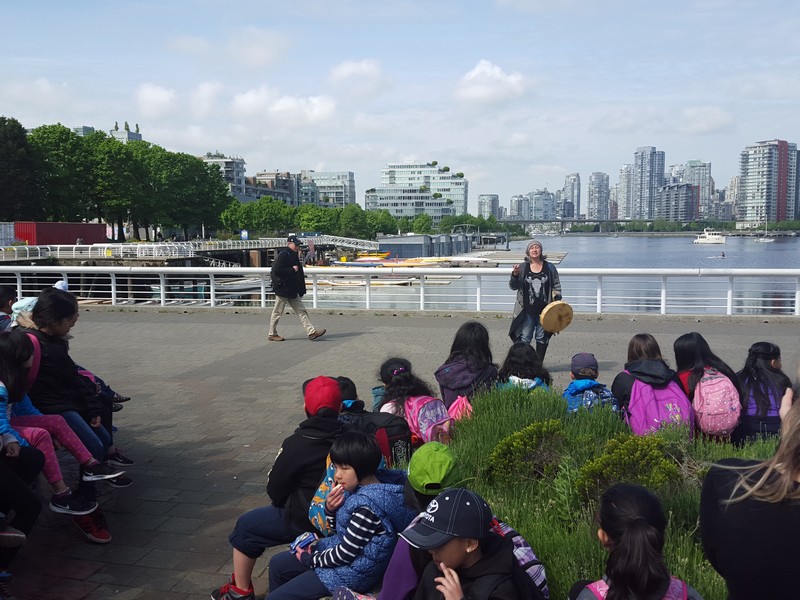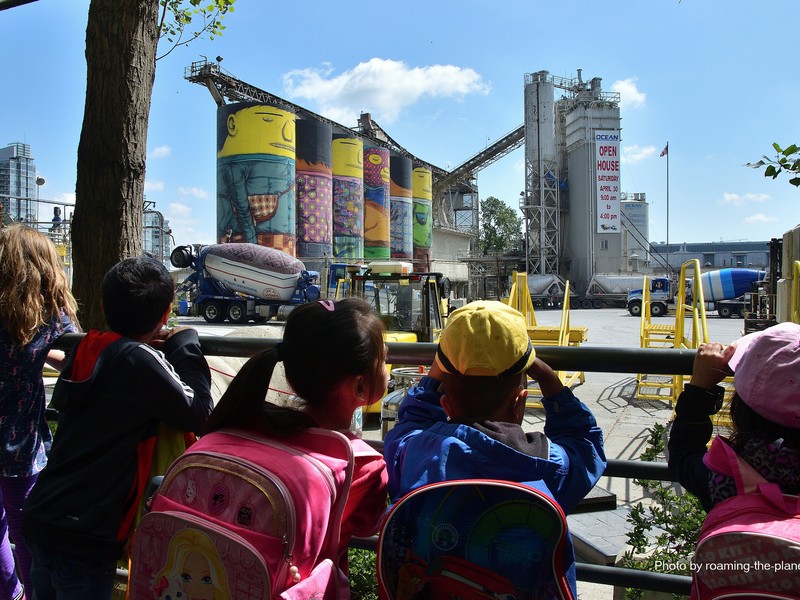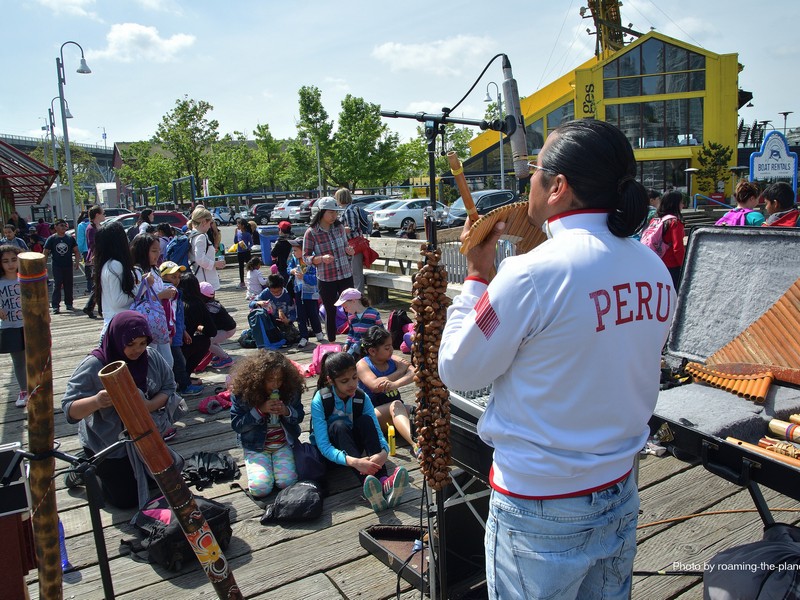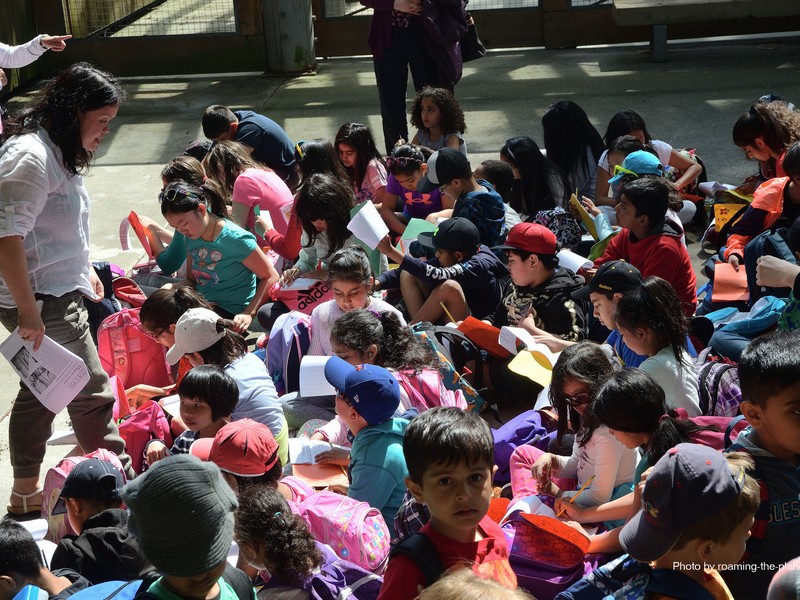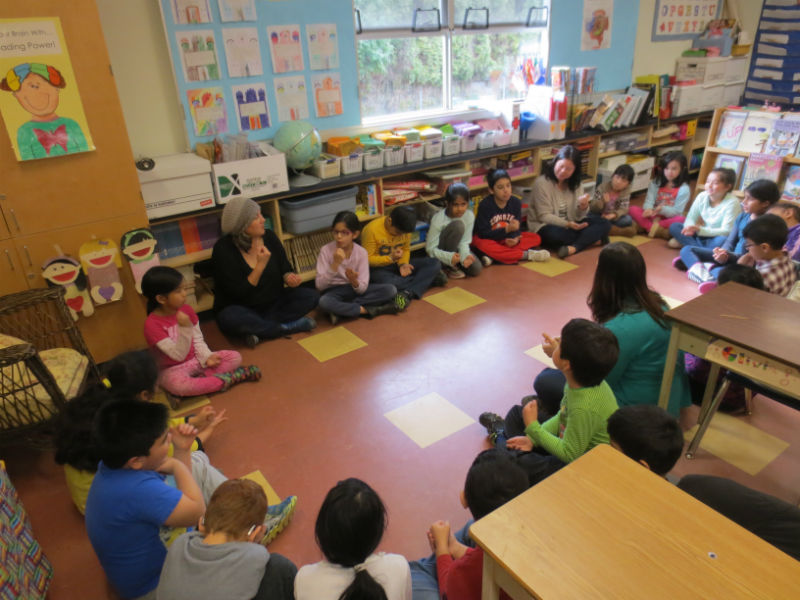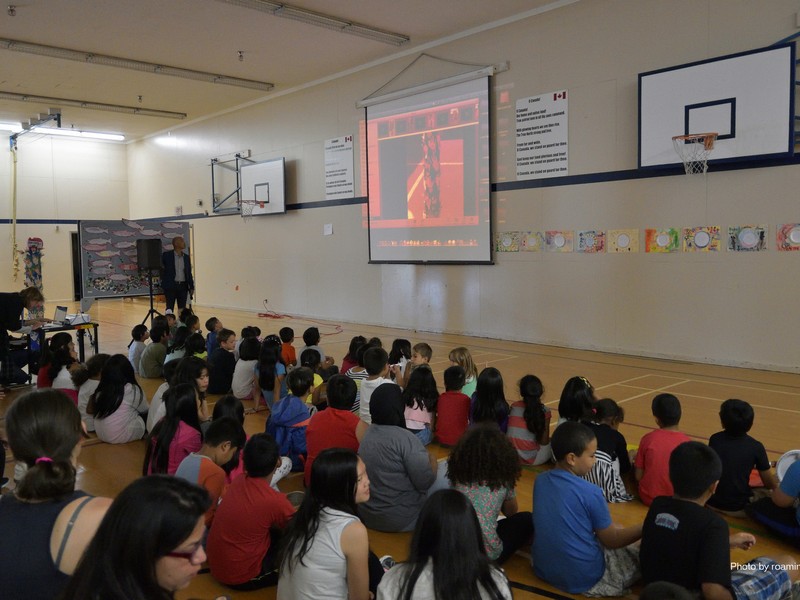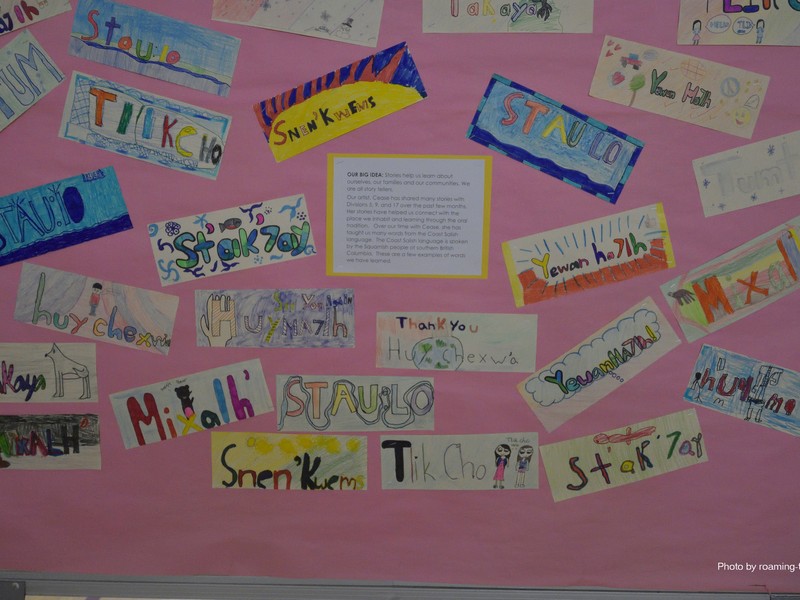Mitchell Elementary: Talking Poles – The Voices of our Totems
Arts Education, Language Arts, Mathematics, Science, Social Studies
School: Mitchell Elementary School
Teacher: Anita Lau/Judy Ong, Stacey Orban/Shannon House, Bonnie Yipp, Harmony Widing
Artist Collaborators: Cease Wyss
Class: Kindergarten, Grade 2/3, Grade 4/5
Overview
Through interactions with Cease Wyss and support staff from Richmond School District #38 (Lynn Wainwright and Leanne McColl) and with Biennale art installations (Trans-Am Totem, Giants and Talking Poles or Talking Circle) students began a past, present and future journey of exploration of their own stories. In the past, they traced their roots to their ancestors. In the present, students thought about what represents their own character. In the future, they began to think more deeply about the legacy they want to leave for future generations. Student understanding was reflected throughout their artistic creation process.
The project was guided by the First Peoples Principles of Learning teaching us that learning is embedded in memory, history, and story, and that it requires exploration of one’s identity. There is a story within each of us. Each of us is a storyteller. The Totem represents our stories. It is a Talking Pole of sorts that documents the voices of our past, present and future. By listening carefully, we hear the voices of our ancestors. By living mindfully, we create meaningful stories of the present. By forward thinking, we leave a sustainable legacy for future generations. Together, the talking poles form the Circle, a community built upon the values and voices of our totems. In this project, Talking Poles-The Voices of Our Totems, the students learn to listen, find our voice and discover the voices of our community.
Connection to the Vancouver Biennale Exhibition
The project is inspired by two Biennale Art pieces. The first one is Trans Am Totem by Marcus Bowcott and the second is Giants by Osgemeos. In addition, the art installation Talking Poles by Cease Wyss enriches our art inquiry.
Artful Inquiry #1: Trans Am Totem by Marcus Bowcott
We explore the meaning of the Totem in Marcus Bowcott’s sculpture. We study the meaning behind Totem Poles in West Coast First Nations. With this background understanding, students can begin to think about what symbols represent them as they create their own Totem Poles in this study.
On this learning journey, students explore the past, the present and the future. In the past, they trace their roots to their ancestors. In the present, students think about what represents their own character. In the future, we begin to think more deeply about the legacy they want to leave for future generations.
Along the way, students gain insight into this place where they live. Marcus Bowcott speaks about the history of place in his Artist Statement, ‘before the introduction of heavy industry, this site was a shoreline of tidal flats and massive forest with old growth cedars and Douglas Firs in the vicinity of Musqueam, Squamish and Tseil-Watuth Nations.’ The artist encourages us to reflect on how a place evolves through time: ‘Trans Am Totem reflects upon this site and its history through references to old growth forest, logging and stacked, manufactured structures.’ Through Cease’s teachings, students learn about how the land looked and how people lived through the eyes of the First Peoples of this land. Students gain a better understanding of time and place. Continuing on the timeline, students explore how settlers and immigrants have changed the landscape and identity of Richmond. Students look at the evolving history of Richmond and deepen their understanding of the place where they live. The students explore the importance of our Elders and explore their individual roots.
Learning Approach: Interview with an Elder, Immigration, West Coast First Nations stories, Totems, Art and Symbols, Family histories, Identity project
Trans Am Totem also speaks about the Sacred Balance of nature and modernization. The sculpture is a visual juxtaposition of the natural world (old growth cedar) and modernisation (throw away consumer culture.) ‘By stacking smashed automobiles and levitating them high above the roadway, Bowcott’s sculpture serves to remind us of the ultimate responsibilities we bear to our planet and future generations.’ The project examines this idea through Chief’s Seattle’s famous speech and explores Indigenous teachings on how to care for the Earth. The Earth does not belong to us. We belong to the Earth. Students explore their ecological footprint and take action to lessen their own impact. The land surrounding Mitchell Elementary was once farmland, but is now occupied by industry, retail buildings and housing. A recent project called “the Pollination Pasture” seeks to support bees in nearby Bath Slough.
Learning Approach: Clean Bin project, taking action at school, recycled art, lessons in the garden and natural world.
Artful Inquiry #2: Giants by Osgemeso
Mitchell has a vision for the schoolyard to be a gathering place for students, teachers and members of the community to engage in learning about the natural world and community and functions as an Outdoor Classroom. Giants by Osgemeso inspires the framework for building our sculptures in the schoolyard. Location is an important piece in this installation. The twins Gustavo and Otavio write ‘we decided to find a place where the painting can be transformed…while sharing perspectives and cultures and establishing a relationship between the people who frequent this site and integrate this work into the city scenery.’ Osgemeso noticed ‘the connection between water and land on Granville Island, on the False Creek margins, also had a lot to do with the choice of location. For us, the water acts as a vein, symbolising life, and it is very present in our work.’ Similarly at Mitchell, we see our evolving schoolyard garden as a sanctuary where we can grow our own crops, listen to one another’s stories and invite the community. The playful nature of Giants and how the sculptures create ‘a dialogue between the 2D and 3D worlds’ inspire us to create 3D sculptures in our garden to evoke playfulness and dialogue. Osgemeos’ quote ‘Every City needs art and art has to be in the middle of the people’ speaks strongly to us at Mitchell. Indeed, we believe every school needs art and art has to be in the middle of the students. We intend to repurpose used cardboard tubes and use recycled materials in the creation of our sculptures. An extension is to explore graffiti in art and social justice issues. We may also choose to create fired clay collaborative totems depicting the stories of our students.
Learning Approach: Poetry around Sense of Place, Graffiti, 3D sculpture, repurposed art materials, garden lessons, community building
Artful Inquiry #3: Talking Poles, by Cease Wyss
Talking Poles, an art installation in Surrey, by the project BIG IDEAS artist Cease Wyss, inspires the idea of creating our own ‘Talking Pole’ in our garden and tapping into the multicultural tapestry of our community our project. Storytelling, listening and community engagement are important threads in this installation. With the rich multicultural composition of families at Mitchell, it would be wonderful to record different languages to welcome one another. The Circle will be central to our lessons as we engage in active listening and the oral tradition of passing down knowledge. The students explore what happens when our voices are silenced by taking a critical look at Residential Schools in Canada and explore the importance of having a voice to speak for ourselves and to stand up for those who don’t have a voice.
Learning Ideas: multiculturalism, storytelling, social justice issues, residential school, potluck gathering to celebrate community
*lessons were adapted accordingly for each age group.
BIG IDEAS
Stories help us learn about ourselves, our families, and our communities
Guiding Questions
Our learning is embedded in story: what do we learn from the stories of our ancestors, from the stories of our communities and from our own personal stories? What stories will we leave for future generations? What happens when our stories are silenced?
Cross-Curricular Access
In B.C.’s transformed curriculum, the Language Arts Big Idea “Stories help us learn about ourselves, our families, and our communities” transcends the primary years and becomes “Exploring text and story helps us understand ourselves and make connections to others and to the world” in the intermediate years. The stories will lead us into our past, our present and our future.
Connected Social Studies primary Big Ideas include “We shape the local environment, and the local environment shapes who we are and how we live” and “Healthy communities recognize and respect the diversity of individuals and care for the local environment.” In the intermediate years we recognize the importance of “Immigration and multiculturalism {which} continue to shape Canadian society and identity.” Our stories are unique yet similar. Our stories help us to understand ourselves and our place in this world. We will note our ancestral countries on a world map (this was also done at our fall potluck.)
The Personal and Social competency of the new curriculum (the set of abilities that relate to students’ identity in the world, both as individuals and as members of their community and society. Personal and social competency encompasses the abilities students need to thrive as individuals, to understand and care about themselves and others, and to find and achieve their purposes in the world) are addressed as we learn to have confidence and pride in our heritage and learn to respect the diversity in which we live and thrive.
Mathematical Literacy concepts will be addressed in the construction of the totemesque structures (geometry).
Science concepts are easily linked during our inquiry relating to TransAm Totem, where we will explore the Sacred Balance of nature and modernization. Mitchell School was formally surrounded by farmland, but industry, housing and retail buildings now occupy those lands. In our garden, we offer the opportunity to learn about food literacy and about the connection between farm and table. We will study the importance of mason bees and how we can support them by building houses and connecting to the Pollination Pasture project in nearby Bath Slough.
Learning Process/Inquiry Challenges/Timeline
1. By listening and observing carefully, we hear the stories of our ancestors. Grades 4/5 Why is it important to know who you are and where your ancestors are from? What is an ancestor? Share and discuss. Web ideas together on the board. Students interview parents/elders where they are from and together as a class on one world map, map the different places our ancestors are from. In a Talking Circle all classroom members introduce themselves and their ancestral heritage, starting with the teacher.
As an extension, we ask “ What is an elder? What lessons/teachings can the elders provide us? What are some stories that our elder has told us from the past? What are some cultural traditions in your family passsed on from your elder? Why are elders important?’
Students interview an elder from their family and enerate questions together as a class. Students share a picture of their elder and explain how they are connected to the elder. Students bring an artifact from their elder that might explain their connections and help uncover their story.
2. Each of us is a storyteller. The Totem represents our stories. We learn to find our voice. Gr 2/3 Big Question: What is my story? Who am I? We invite students to examine and share their own identities as a way to build relationships in our class and community. In so doing, students define the word identity, discover their individual identity and identify various factors that shape their identity. Students begin to explore the concept of community by describing their class as a collection of people with unique identities. Students begin to see the common characteristics that make them a group as well as the distinct qualities they each bring to their classroom community. Activities include interviewing an Elder and creating Identity Charts. Some guiding questions include:
- Who is in your family?
- Where is your family from?
- What languages do they speak?
- What does your family hope for your future? What do YOU hope for your future?
- How did you get your name?
Students are invited to create an identity chart and present it to the class.
Students think about what aspects of their identity are most important to them. They select one characteristic from their identity chart and write about why it is an important part of defining who they are. Students may wish to bring in an artefact that helps to uncover their identify. Students can then use that important aspect of their identity to help guide them in creating their clay pieces later on.
Language Activity – Creating Biopoems
Students create an 11-line poem that describes them. Focusing on their experiences, hopes, and accomplishments rather than on basic characteristics such as gender, height, age, and race.
Art Connection
After our field trip to see the Giants, we propose the creation of a collaborative 3D sculpture.
3. By using various meaningful natural materials, i.e. story stones, students will learn to create and imagine unique stories about themselves, their families and the world around them – Kindergarten
Students learn to respect and acknowledge everyone’s unique and special ideas and perspectives in order to build shared understanding and meaning of identity. They were given opportunities to respectfully listen and to talk about their feelings, opinions, perspectives and expressions.
Before starting the story stones, the children discuss using the pictures to introduce a new setting, a new character or to build a new situation. They are encouraged to introduce twists and turns in the story, use emotions and tones to make the story comic, scary, happy or thrilling. For the more advanced children, they may also be introduced to notions of beginning, middle and end.
Examples of discussion questions:
What does a scary person sound like and look like?
What does a pineapple taste like?
How do you feel when you lose a teddy bear?
What do you see by the castle?
To begin, children take turns to choose a stone from the basket, and start a story based on the picture on the stone that they’ve chosen. Another stone is drawn from the basket, and the story continues, incorporating this next picture into it. One child can be telling this story, or he/she can pass the basket around at circle time, so that each child draws a stone, and adds another sentence to the story. The ‘story stones’ are meant to be open-ended with unlimited possibilities. These stories help to foster children’s creativity, imagination, connections and critical thinking.
As children become more and more encouraged, supported and comfortable with the story stones, they learn to generate their own stories, their own perspectives and their own ideas using these stones.
Inspired by the book: Only One You, by Linda Kranz
Student Creation
After having completed discoveries about their own identities, voices and stories, students create a clay cylindrical tile that represents who they are. The tiles are assembled to form totemesque structures and are displayed in the school garden.
Related Material
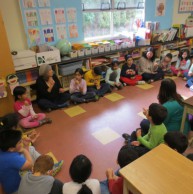 Mitchell Sharing at 2016 Richmond BIG IDEAS Celebration
Mitchell Sharing at 2016 Richmond BIG IDEAS Celebration